By David "Chet" Williamson Sneade
He was known as the “Black Cyclone” and the “Worcester Whirlwind.”
He was Marshall “Major” Taylor, a three-time world champion cyclist and one of
the first Black American champions in any American sport.
He was also a musician who may have played ragtime in the
pre-jazz era. Taylor sang and played both the mandolin and piano and received
his nickname in a band setting. This item ran in the February 21, 1900 edition
of the Worcester Daily Telegram: “Marshall Taylor is his real name, but Major
he has been ever since he was a 10-year old boy at school, he wielded a baton
in front of a juvenile band.”
Taylor was born on November 26, 1878 in rural Indiana and
raised in Indianapolis, but he became a champion in Worcester. His life was one
of great triumphant and equal tragedy. He died penniless in Chicago on June 28,
1932.
His story is well documented. There are a collection of books,
numerous articles, and websites dedicated to his greatness. Here in Worcester,
a handsome statue of his likeness stands outside the library, a street has been
named after him, and annual cycling events happen in his honor.
Little is known about his musical life. What we do know is that
in his downtime, he liked to play music. At one point – at the height of his
championship reign -- Taylor used his fame to enter vaudeville.
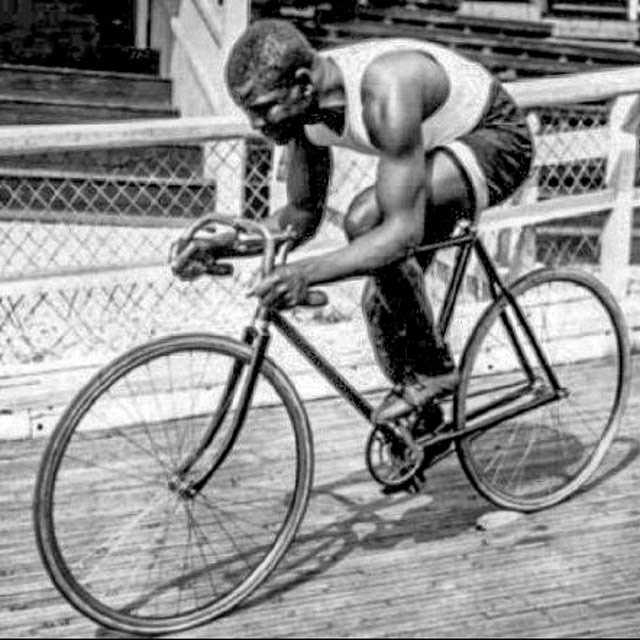 In his landmark book, Major Taylor: The Extraordinary Career
of a Champion Bicycle Racer author Andrew Ritchie wrote about this experience.
“There was talk of Taylor going after more motor-paced records, benefiting from
his end-of-season strength and fitness to attack the prestigious 1-mile world
record, as he had done at the end of 1898 and 1899. But instead of undertaking
the stress and strain of more record breaking, Taylor embarked on a new career.
Capitalizing on his success and fame as champion of America, he decided to go
into vaudeville."
In his landmark book, Major Taylor: The Extraordinary Career
of a Champion Bicycle Racer author Andrew Ritchie wrote about this experience.
“There was talk of Taylor going after more motor-paced records, benefiting from
his end-of-season strength and fitness to attack the prestigious 1-mile world
record, as he had done at the end of 1898 and 1899. But instead of undertaking
the stress and strain of more record breaking, Taylor embarked on a new career.
Capitalizing on his success and fame as champion of America, he decided to go
into vaudeville."
Ritchie notes that vaudeville was the popular entertainment of
the day and part of Taylor’s everyday experience. The writer says that the cyclist had a
fine singing voice and like other athletes before him, he would have been quite
the novelty on stage.
Unfortunately, he did not get to share his piano playing with
vaudeville audiences. As Ritchie says, Taylor was a bicycle racer after
all and that in itself made him a popular entertainer. The cyclist was contracted by local agent Charles Culver, the manager of the Worcester Coliseum on Shrewsbury
Street. Instead of a musical performance, Taylor agreed to ride a stationary
bike known as ‘home trainer,’ a kind of treadmill for cyclists. He was to
compete against one of his rivals, the famous Charlie ‘Mile-a-Minute’ Murphy,”
who is credited with – as his name implies -- being the first cyclist to ride a
mile in one minute's time.
 |
| Worcester Daily Telegram, 1901 |
Ritchie picks up the action: “Home trainers were set up
alongside each other on the stage of a theater and connected to big dials,
which showed the distance the two riders had covered by means of two big
arrows. The machines were splendidly set up on stage, decorated with flags. With
firing of a pistol, the race began, the two men pedaling furiously, while the
audience followed the sprinting in front of the roaring, cheering crowd.
“Culver thought the act would be an instant hit, and he was
right. When it opened at the Park Theater in Worcester at the end of October,
sandwiched between comedy routines, acrobatics, song and dance acts, and moving
pictures, it was an instant success. The audience ‘cheered until it was hoarse
as the race progressed,’ reported the Worcester Telegram, ‘bursting into wild
enthusiasm when the dial at the rear of the stage showed the riders’ progress,
and one followed them as they moved around the circle with as much interest as
one would riders on a race track.’"
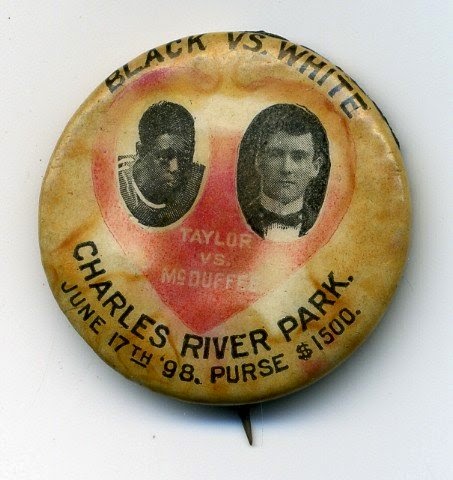 Ritchie says that from Worcester, this unusual vaudeville team
played to packed houses in Pittsfield, Springfield, Hartford, and other cities
and towns throughout New England.
Ritchie says that from Worcester, this unusual vaudeville team
played to packed houses in Pittsfield, Springfield, Hartford, and other cities
and towns throughout New England.
“Taylor also rode a mile on his home trainer in the window of
a Hartford bicycle dealer’s shop in the record time of 43½ seconds, a speed
equivalent to 82.5 mph. A crowd of more than a thousand people watched him,”
Ritchie says. “Having established the success of the act, Culver contracted
with Keith’s Theater in Boston for the two cyclists to appear nightly on the
Boston stage, and the home trainer races continued throughout December and
January. Keith was perhaps the most famous vaudeville company on the East
Coast, and it was they who pioneered the idea of a continuous, revolving
performance, which the audience could enter and leaved as they pleased.”
Taylor traveled to Europe and Australia to compete for his
world championships. In 1901, he spent four months in France, from March to
June, which as Ritchie says, “proved to be the climax of his athletic career.
At the zenith of his physical strength and international popularity, he arrived
in France at the culmination of a long period of rumors and promises of his
imminent coming. Promoters and spectators were hungry for the new sensation.
There would be something magical about the first visit, something that gripped
the public imagination. …
“One evening, the entire staff of L’Auto-Velo took him to the
circus to see ‘Little Chocolate,’ the clown, the only other famous black person
in Paris at the time. ‘Chocolate’ referred to Taylor’s presence during his
performance, and all eyes in the theater were turned towards the box where
Taylor sat, enjoying himself immensely.”
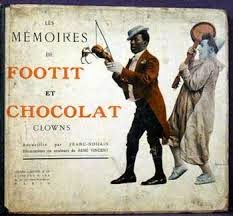.jpg) This celebrity status was two decades before black American
entertainers, such as dancer Josephine Baker and jazz musician Sidney Bechet,
became the darlings of the French.
This celebrity status was two decades before black American
entertainers, such as dancer Josephine Baker and jazz musician Sidney Bechet,
became the darlings of the French.
Ritchie says when “not training, or giving interviews at
his hotel, or visiting the sights of Paris, Taylor read and wrote letters or
played the piano or mandolin. He was also a keen photographer and took pictures
with the portable Kodak he had brought with him from the United States.”
In their book, Major Taylor: The Inspiring Story of a Black
Cyclist, Conrad and Terry Kerber say that the champion cyclist, was a somewhat
frustrated musician. Quoting a French newspaper article of the day, the Kerbers
state that the cyclist was a self-taught pianist, who “because of his hectic schedule,
hadn’t found the time to play [the piano] as often as he had wished.” Taylor
was staying at the Malesherbes Hotel and in the lobby was a beautiful black
Steinway piano.
The writers also add that on one particular night he was “in a
melodious mood, he drew up a vacant stool, set his bowler hat on top of the
piano and sat down. Initially a small crowd noticed and gathered around him.
Taylor played tentatively. The small crowd grew. Warming to the gathering,
Taylor started singing “Hullo My Baby,” an American song made popular during
the 1900 Paris Expo. The crowd joined in.
"One journalist, who was present at the gathering said that he
had a 'remarkable singing voice.' Taylor’s hands poured across the piano, feet
stomping on the pedals, voice wafting throughout the room. Champagne was
brought out, and people listened and sang and slurped.”
“Hello, Ma Baby,” is an interesting choice for Taylor to sing.
It’s not really a piece of ragtime music, although it refers to the popular
music of that time: “Hello! ma baby, Hello! ma honey, Hello! ma ragtime gal.” The song was actually written by the
Tin Pan Alley team of Joseph E. Howard and Ida Emerson in 1899. It also harks
back to an early time, the Minstrel-era and the derogatory styling known as
“coon songs.”
The song, first recorded by Arthur Collins on Edison, is said
to be the first tune of its kind that refers to the newly invented device, the
telephone. The chorus refrain is complete with: Send me a kiss by wire / Baby,
ma heart's on fire! / If you refuse me / Honey, you'll lose me / Then you'll be
left alone / Oh, baby, telephone / And tell me I'm your own!”
According to Wikipedia, the chorus is “far better known than
its verse, as the introductory song in the famous Warner Bros. cartoon One
Froggy Evening (1955), sung by the character later dubbed Michigan J. Frog and
high-stepping in the style of Bert Williams.”
 |
| Scott Joplin |
Needless to say, Ragtime this is not. Artistically, this is a
long way from say, Scott Joplin’s “Maple Leaf Rag,” the composition that launched ragtime's popularity in 1899.
As for Taylor playing ragtime piano, no record exists.
However, it is conceivable and most probable that a proud African-American,
would have played the most popular and artistic black art-form of the day.
Worcester
As mentioned, much has been written of Taylor’s life in
Worcester. He moved here in the fall of 1895 when he was only 15. He relocated
from his native Indianapolis with his employer, Louis “Birdie” Munger, a
bicycle maker and racing enthusiast who opened the Worcester Cycling
Manufacturing Company.
The Worcester Daily Telegram reported that soon after his
arrival the young cyclist competed in a race presented by the newspaper. “After
winning the Telegram race, Major Taylor’s fame increased rapidly,” a reporter noted.
Coming to Worcester turned out to be the right move at the
right time for Taylor. In his autobiography, The Fastest Bicycle Rider in the
World, Taylor wrote: “I was in Worcester only a very short time before I
realized that there was no such race prejudice existing among the bicycle
riders there as I had experienced in Indianapolis. When I realized I would have
a fair chance to compete against them in races I took on a new lease of life,
and when I learned that I could join the YMCA in Worcester, I was please beyond
expression. … It did not take me very long to get acquainted in Worcester, especially
when its riders discovered that I owned a fine, light, racing wheel on which I
could ride with the best of them.
“I shall always be grateful to Worcester as I am firmly
convinced that I would shortly have dropped riding, owing to the disagreeable incidents
that befell my lot while riding in and around Indianapolis, where it not for
the cordial manner in which the people received me.”
 |
| Mrs. Taylor, Major and daughter Sydney |
Taylor not only lived and trained here, he married, raised a
child, and purchased a home in Worcester, at 2 Hobson Ave. He was a member of the John
Street Baptist Church and when not traveling, the champion cyclist, worked a
variety of jobs in addition to being employed by Munger.
He first became champion at 21. He was out of racing by 1910
at the age of 32. His decline was as steep as George Street hill.
Local writer Albert Southwick chronicled Taylor’s slide: “He
invested $15,000 in a business venture that flopped. He tried to enter
Worcester Polytechnic Institute to study engineering, but was turned down,
ostensibly because he had no high school degree.
“Then his health began to give way. He may have had an
enlarged heart from all those years of training. In the 1920s, he came down
with shingles, a painful, debilitating disease. With no steady income, he was
forced to sell off his wife’s jewelry and other items that he had purchased in
better times. Finally he had to sell their home on Hobson Avenue and they moved
into a modest apartment on Blossom Street.”
Southwick also reported that Mrs. Taylor, who had come from an
educated family, “went to work as a seamstress. Gradually she became estranged
from Taylor, as did [daughter] Sydney. [His] final energies went into his autobiography,
which he published at his own expense under the title The Fastest Bicycle Rider
in the World: The Story of a Colored Boy’s Indomitable Courage and Success
Against Great Odds. It is a long, rambling book, filled with details of
individual races. It does not tell enough about Major Taylor, the man.”
The book was first printed in Worcester by Wormley Publishing. It is dedicated to his former trainer and employer, Louis Munger. In its forward,
Taylor wrote: “I am writing my memoirs, however, in the spirit of calculated to
solicit simple justice, equal rights, and a square deal for the posterity of my
down-trodden but brave people, not only in athletic games and sports, but in
every honorable game of human endeavor.”
Continuing to describe the champion’s demise, Southwick says
that while ill and broke, “Taylor went from door to door selling his book. His
wife, unable to stand the strain any longer, left Worcester and went to New
York. She never saw him again. In 1930, he too, left Worcester and headed for
Chicago, his car filled with copies of his book. In Chicago, he live at the
YMCA, from which he went forth every day to peddle his autobiography.
Taylor died on June 21, 1932, in the charity ward of Cook
County Hospital. He is buried in a pauper’s section of the Mount Glennwood
Cemetery. He was 54. According to Southwick, The Chicago Defender, a black
newspaper, was the only one to note the Worcester Whirlwind’s death.
Note: This is a work in progress. Comments, corrections, and suggestions are always welcome at: walnutharmonicas@gmail.com. . Also see: www.worcestersongs.blogspot.com Thank you.
Resources











.jpg)









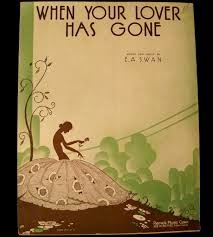.jpg)



















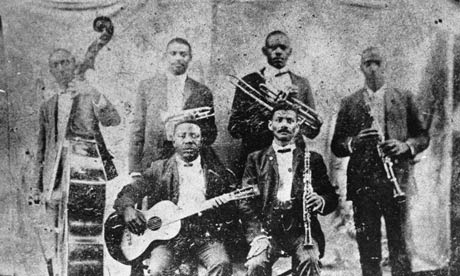






.jpg)




2.jpg)

